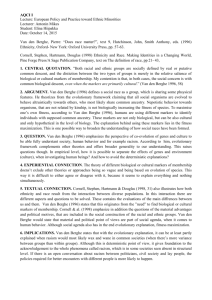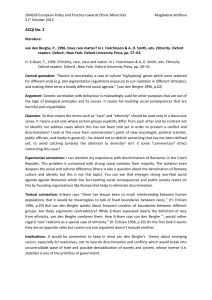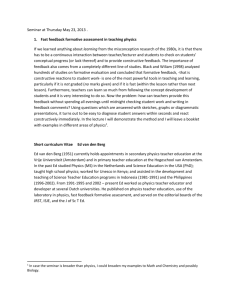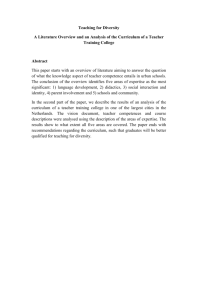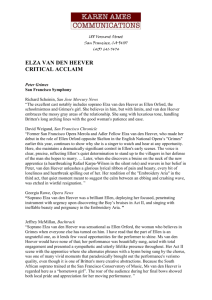AQCI I Lecture: European Policy and Practice toward Ethnic
advertisement
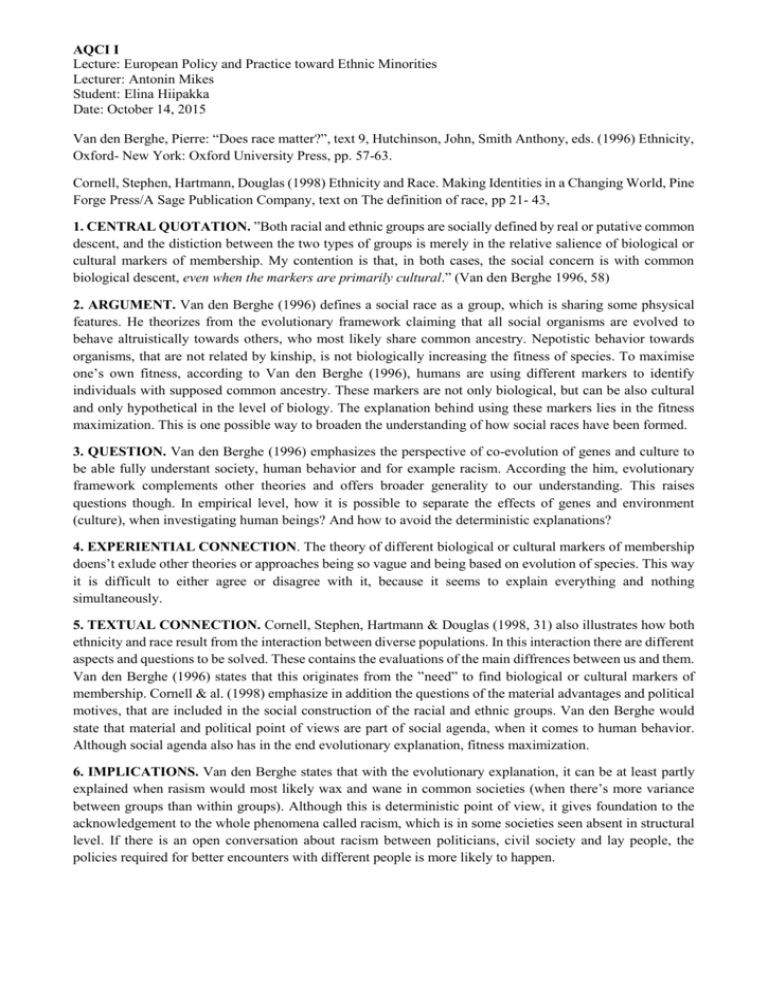
AQCI I Lecture: European Policy and Practice toward Ethnic Minorities Lecturer: Antonin Mikes Student: Elina Hiipakka Date: October 14, 2015 Van den Berghe, Pierre: “Does race matter?”, text 9, Hutchinson, John, Smith Anthony, eds. (1996) Ethnicity, Oxford- New York: Oxford University Press, pp. 57-63. Cornell, Stephen, Hartmann, Douglas (1998) Ethnicity and Race. Making Identities in a Changing World, Pine Forge Press/A Sage Publication Company, text on The definition of race, pp 21- 43, 1. CENTRAL QUOTATION. ”Both racial and ethnic groups are socially defined by real or putative common descent, and the distiction between the two types of groups is merely in the relative salience of biological or cultural markers of membership. My contention is that, in both cases, the social concern is with common biological descent, even when the markers are primarily cultural.” (Van den Berghe 1996, 58) 2. ARGUMENT. Van den Berghe (1996) defines a social race as a group, which is sharing some phsysical features. He theorizes from the evolutionary framework claiming that all social organisms are evolved to behave altruistically towards others, who most likely share common ancestry. Nepotistic behavior towards organisms, that are not related by kinship, is not biologically increasing the fitness of species. To maximise one’s own fitness, according to Van den Berghe (1996), humans are using different markers to identify individuals with supposed common ancestry. These markers are not only biological, but can be also cultural and only hypothetical in the level of biology. The explanation behind using these markers lies in the fitness maximization. This is one possible way to broaden the understanding of how social races have been formed. 3. QUESTION. Van den Berghe (1996) emphasizes the perspective of co-evolution of genes and culture to be able fully understant society, human behavior and for example racism. According the him, evolutionary framework complements other theories and offers broader generality to our understanding. This raises questions though. In empirical level, how it is possible to separate the effects of genes and environment (culture), when investigating human beings? And how to avoid the deterministic explanations? 4. EXPERIENTIAL CONNECTION. The theory of different biological or cultural markers of membership doens’t exlude other theories or approaches being so vague and being based on evolution of species. This way it is difficult to either agree or disagree with it, because it seems to explain everything and nothing simultaneously. 5. TEXTUAL CONNECTION. Cornell, Stephen, Hartmann & Douglas (1998, 31) also illustrates how both ethnicity and race result from the interaction between diverse populations. In this interaction there are different aspects and questions to be solved. These contains the evaluations of the main diffrences between us and them. Van den Berghe (1996) states that this originates from the ”need” to find biological or cultural markers of membership. Cornell & al. (1998) emphasize in addition the questions of the material advantages and political motives, that are included in the social construction of the racial and ethnic groups. Van den Berghe would state that material and political point of views are part of social agenda, when it comes to human behavior. Although social agenda also has in the end evolutionary explanation, fitness maximization. 6. IMPLICATIONS. Van den Berghe states that with the evolutionary explanation, it can be at least partly explained when rasism would most likely wax and wane in common societies (when there’s more variance between groups than within groups). Although this is deterministic point of view, it gives foundation to the acknowledgement to the whole phenomena called racism, which is in some societies seen absent in structural level. If there is an open conversation about racism between politicians, civil society and lay people, the policies required for better encounters with different people is more likely to happen. AQCI I Lecture: European Policy and Practice toward Ethnic Minorities Lecturer: Antonin Mikes Student: Elina Hiipakka Date: October 14, 2015 Sample Self assessment form Department of Public and Social Policy, Faculty of Social Sciences, Charles University AQCI ASSESSMENT FORM Student’s name: Name of assessor: Date: Essay title: Excel lent 1) Is the chosen quotation central to the author’s argument? 2) Has the main argument been fully understood (including its ‘for’ and ‘against’ sides, if applicable)? 3a) Is the question raised important/relevant/interesting? 3b) Has this question not been fully answered in the text? 4) Is the experiential connection relevant/interesting? 5a) Is the textual connection relevant/interesting? 5b) Has it been cited properly? 5c) Has it been adequately explained how the present text's argument contrasts with, contradicts, confirms, clarifies, or elaborates the other text's argument or point? 6) Have the implications been well understood, can they have a practical impact for policy making? 7) Expression/Presentation a) Are the style, grammar and general use of English adequate? b) Is the AQCI professionally presented? Essay grade: Further comments: Go od Aver age Po or Not accept able Comments
